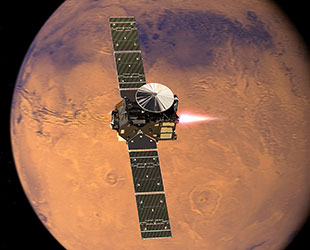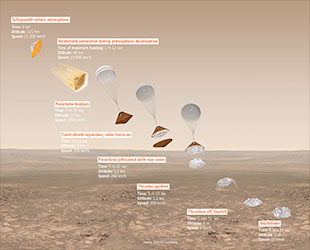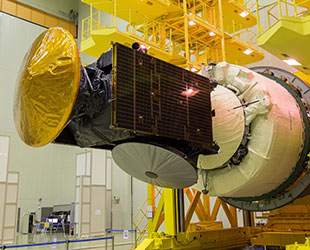October 20, 2016 — Europe has a new spacecraft circling Mars, but the fate of its companion experimental lander is lost in the telemetry it transmitted, if not also physically lost on the Red Planet itself.
The European Space Agency's (ESA) ExoMars Trace Gas Orbiter (TGO) entered orbit on Wednesday (Oct. 19) after a seven-month journey from Earth. The spacecraft, which is designed to search for signs of life in the atmosphere, is considered a cornerstone of the ExoMars program, a joint effort between ESA and Russia's Roscosmos, which also includes sending a European rover and a Russian surface platform to the planet in 2020.
"TGO is now ready for science and at the same time ready for data relay, which we need for the 2020 mission," stated Jan Woerner, ESA Director General, in a press briefing on Thursday. "TGO is a cornerstone of the ExoMars 2016, as well as 2020 missions."
On Wednesday, TGO performed a 139-minute engine burn to slow its approach, allowing Mars' gravity to capture and pull it into a highly elliptical orbit. Beginning in January, the spacecraft will initiate a year-long period of maneuvers to attain its science operations and radio-relay circular orbit, 250 miles (400 km) above the planet's surface.

Artist's impression visualizing the ExoMars 2016 Trace Gas Orbiter with its thrusters firing, beginning its entry into Mars orbit. (ESA) |
"ExoMars 2016 is oriented towards a multi-year Martian science [campaign] to search for trace gases, to search for life," said Woerner. "This part is really 100 percent now in the future for us, so we will succeed with that."
"At the same time, TGO has another function which is very important, as a [communications] relay station for the 2020 mission when we would like to do ground science on Mars, and again this is established, so we're really confident that we have the right basis for a successful European science [program]."
Three days before TGO entered orbit, the second part of the ExoMars 2016 mission, the Schiaparelli entry, descent and landing demonstrator, separated from the orbiter. On Wednesday, as TGO fired its engine to insert itself around Mars, Schiaparelli headed for the surface.
Signals from Schiaparelli received by the Giant Metrewave Radio Telescope, the Earth's largest interferometric array located in Pune, India, confirmed that the lander survived its plunge from 75 miles (121 km) into the atmosphere and had deployed its supersonic parachute. TGO also received the telemetry from Schiaparelli and sent it back to Earth in the early hours on Thursday.
"We can definitely say it has gone through the upper layers of the atmosphere according to our expectations and then it reached an altitude over the surface when it deployed its parachute, again according to expectations," said Andrea Accomazzo, ESA's spacecraft operations manager. "This means not only did it functionally work from a timing point of view, but also the heat shield that was protecting the [lander] throughout the atmospheric phase at high velocity has worked flawlessly."

Overview of Schiaparelli's entry, descent and landing. (ESA/ATG) |
The telemetry relayed through TGO also showed that the lander, named for the 19th century Italian astronomer, fired at least some of its thrusters but for a shorter duration than expected. From that point on, about 50 seconds prior to when Schiaparelli was anticipated to land, communications were lost.
"It could be that the parachute phase was terminated too early and then we were far too high, or we had a behavior during the parachute phase that led to the lander being far too low," Accomazzo described. "From the data we have processed so far, we are not in the position to conclude on that specific point."
The condition of Schiaparelli on Mars' surface is presently unknown. It had been targeted to touch down in a region of the planet called Meridiani Planum, close to where NASA's Opportunity rover landed in January 2004.
"Unfortunately, we are not in a position yet, but we will be, to determine the dynamic condition at which the lander has touched the ground and then we will know if it could have survived structurally or not," said Accomazzo.
In addition to continuing to analyze the data received from Schiaparelli, NASA's Mars Reconnaissance Orbiter (MRO) will listen for signals from the lander, as well as eventually try to image the area where it was expected to have touch down.
"The likelihood to really get a picture is difficult to judge," said Accomazzo. "Schiaparelli [will be] extremely small in these images ... so it might take quite some time before we are in a position to locate it physically on the ground."
The Schiaparelli probe was primarily designed to test the technologies for entry, descent and landing in support of the ExoMars 2020 rover mission. Schiaparelli had though, been outfitted with a small meteorological station designed to operate for a few days before its batteries were drained.

The ExoMars 2016 Trace Gas Orbiter (TGO) and Schiaparelli lander seen prior to being encapsulated for launch. (ESA/B. Bethge) |
If Schiaparelli did crash, it will join a long history of failed missions sent to Mars. Out of the dozen or so probes and rovers that tried to land on the Red Planet, less than half survived and all that did successfully were U.S. probes.
NASA's Viking 1 and Viking 2 landers in 1976, the Mars Pathfinder lander with the Sojourner rover in 1997, the twin Mars Exploration rovers Spirit and Opportunity in 2004, the Phoenix Mars Lander in 2008 and Curiosity Mars Science Laboratory in 2012 all made it to the surface to conduct their intended missions. (Opportunity and Curiosity are the only two that remain active.)
The former Soviet Union attempted five times to land a spacecraft on Mars. Only one probe made it to the ground (let alone to the planet) intact: Mars 3, on Dec. 2, 1971. Though it was the first probe to make a soft landing on the Red Planet, it ceased communicating just 15 seconds after touching down.
Europe's earlier attempt at landing on Mars, Beagle 2 on Dec. 25, 2003, went missing and was presumed lost until January 2015, when images from MRO confirmed Beagle 2 had landed but suggested two of its four solar panels failed to deploy, blocking its communication antenna.
"Mars exploration is hard and that is one of the reasons we do it," remarked David Parker, the ESA director of human spaceflight and robotic exploration. "There is a lot to look forward to with this mission and also to carry on the work preparing for our rover mission in 2020 that will continue ESA's Mars exploration campaign."
